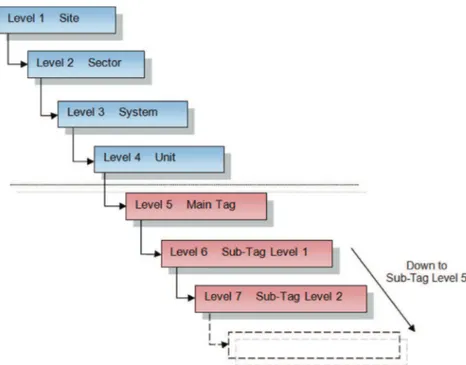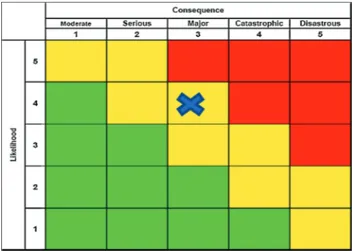O
pen
A
rchive
T
OULOUSE
A
rchive
O
uverte (
OATAO
)
OATAO is an open access repository that collects the work of Toulouse researchers and
makes it freely available over the web where possible.
This is an author-deposited version published in :
http://oatao.univ-toulouse.fr/
Eprints ID : 16009
To link to this article : DOI : 10.1016/j.apor.2016.01.009
URL :
http://dx.doi.org/10.1016/j.apor.2016.01.009
To cite this version :
Kamsu-Foguem, Bernard Information
structuring and risk-based inspection for the marine oil pipelines.
(2016) Applied Ocean Research, vol. 56. pp. 132-142. ISSN
0141-1187
Any correspondence concerning this service should be sent to the repository
administrator:
staff-oatao@listes-diff.inp-toulouse.fr
Information
structuring
and
risk-based
inspection
for
the
marine
oil
pipelines
Bernard
Kamsu-Foguem
∗UniversitédeToulouse,LaboratoiredeGéniedeProduction(LGP),EA1905,47Avenued’Azereix,BP1629,65016TarbesCedex,France
Keywords: Experience Knowledge Inspection Maintenance Riskassessment Equipmentfailure Intelligentpigging Safety Environment Offshoreproduction
a
b
s
t
r
a
c
t
Theproposedworkisincorporatedintotheresearchthemeconcerningthemaintenanceandinspection ofsensitivefacilitiesinproductionsystems.Itisessentialtopromotethemethodologicaldeployment ofinspectiontechniquestoensurethegoodfunctioningofservicesprovidedbycomplexproduction systemsaswellastheirdifferentcomponents.Weusearisk-basedinspectionmethodologyoffering anorganizedanalysiswithknowledgesharingforcollaborativepossibilitiesinamultidisciplinary con-textanditconsistsofthefollowingsteps:dataacquisitionandinformationcollection,failureanalysis (probabilityandconsequences),riskassessment,inspectionplan,mitigationandrevaluation.The appli-cationofthismethodologycanimprovethemaintenancemanagementstrategiesofindustrialcompanies. Theinspectiondepartmentisabletoforecastitspotentialfailure,rootcausesandimpactsonthesafe operationoftheconsideredproductionsystem,basedonareliableinventoryofexistingsituationsand reviewoptionsforcontinuousimprovementinmaintenancemanagement.Inparticular,weaddressed theapplicationofaRisk-BasedInspection(RBI)methodologyintheFrenchpetroleumcompanywith operationsonthewestcoastofcentralandsouthernAfrica.Theincorporationofexpertknowledgeinto riskassessmentishelpingtofindthebestpreventiveplanforpipelineinspectioninthecasestudy.
1. Introduction
Thecurrentmanagementframeworksofindustrialenterprises
mustintegrateengineeringstandardsandrecommendedpractices
toreflecttheincreasingcomplexityofproductionsystems.In
addi-tion,thelegislationrequiresthatenterprisescomplywith
appli-cablenormativerulesbyusingindustrialpracticesthatare
envi-ronmentallyandlogisticallysustainable.Incertaincircumstances,
Abbreviations:Ath,AllowedminimumTHickness;CMIMS,Computerized Main-tenanceandInspectionManagementSystem;Cof,Consequenceofthefailure; CL,CorrosionLikelihood;CR,CorrosionRate;EFF,Effectiveness;ESD,Electrical SchematicDiagram;FPSO,FloatingProduction,StorageandOffloading;HSE,Health, SafetyandEnvironment;HV,High-Voltage;HMI,Human–machineinterface;LAY, Lay-out;Lof,Likelihoodoffailure;LV,Low-Voltage;MAOP,MaximumAllowable OperatingPressure;MOP,MaximumOperatingPressure;MOGA,Multi-Objective GeneticAlgorithm;NCL,NaturalCorrosionLikelihood;P&ID,Pipingand Instru-mentationDiagram;PCS,ProcessControlSystem;PFD,ProcessFlowDiagram;PSS, ProcessSafetySystem;PLC,ProgrammableLogicController;RBI,Risk-Based Inspec-tion;RCM,ReliabilityCentredMaintenance;SLD,Single-LineDiagram;ST,State; SLD/C,StructuraldesignorconstructionfailureLikehood;SLthird,Structuralfailure thirdpartyLikehood;SLmec,StructuralmechanicalfailureLikehood;SLnat, Struc-turalnaturalfailureLikehood;SL,StructureLikelihood;SAP,Systems,Applications &ProductsinDataProcessing;UFD,UtilityFlowDiagram.
∗Tel.:+33624302337;fax:+33562442708. E-mailaddress:Bernard.Kamsu-Foguem@enit.fr
thelawobligescompaniestomakeriskinformation(threat
cryp-togramsandtheassociatedriskandsafetydescriptions)available
ontheindustrial sites.Theincreasingcomplexity ofoiland gas
installationsandoperations,alongwithgrowingpublicawareness
toensurehigherlevelsof safety,hasputgreatpressure onthe
designersandoperatorstofindinnovativesolutionstoensuresafe
aswellaseconomicallyviableoperation[1].Reliabilityand
Main-tenancewithtoolssuchasRCM(ReliabilityCentredMaintenance)
andRBI(Risk-BasedInspection)contributetocollaboratively
work-ingtowardsseekingreasonableandpracticalsolutionsinthe
indus-trialsettings[2].Inscientific literature,therearedifferent
cate-goriesofriskanalysisandrisk-assessmentmethodsandtechniques
(qualitative, quantitative and hybrid approaches) [3]. A varied
rangeofmethodologiespresentlyinuseforrisk-basedinspection
includesmarketableandinternalsoftwarepackagesparticularto
explicitplants[4].Inthecomplexproductionsystems,thework
packageofmaintenanceengineeringisimportanttoensure
conti-nuityofservices,optimizeproductioncapacity,improvesafetyand
reducetheenvironmentalimpact.RiskBasedInspection(RBI)isan
interestingmaintenanceperspectivewithanincrementalstepwise
procedureusedtoexaminesensitiveequipmentsuchaspressure
vessels,heatexchangersandpipingincomplexindustrialplants
[5]. RBI providesa modellingprocess for organizationsto
con-trolitsreliability,safetyandhealthaspects,ensuremaintenance
complianceandtoiterativelyimprovethetechnicalperformance
and cost of projects [6]. However, the implementation of the
RBIrequiresstructuredandcoherentinformationmanagementin
ordertomaximizeitsintegrationinthetargetcomputerized
man-agementinformationsystemformaintenanceandinspection.The
aimofthisworkistoproposeaconceptualapproachproviding
structuredinformation forsemanticmodellingof the
hierarchi-calorganizationofcomponentsthatcharacterizeallthesensitive
areasofacomplexsystemthatmustbeinspectedorverifiedbythe
RBImethod.Thissemanticmodellingwillformalizethetaxonomic
organizationofequipmentandinstrumentsoftheconsidered
sys-tem.These componentsare classifiedaccordingto theirnature
throughthestudyofessential documentsandinformation
pro-videdbyvendorsandthemanufacturerofthesystem.Theobtained
structured information canbe transferred totheComputerized
MaintenanceandInspectionManagementSystem(CMIMS)forthe
managementissues(analysisanddiagnosis)orengineeringissues
(tasklists).
The paper is structured as followed. Section 2 exposes a
backgroundoftheriskbasedinspectionmanagement.Section3
presentstheindustrialchallengeoftheriskbasedinspection
man-agement.Section4presentsthesuggestedmethodology.Section
5.1describesanillustrativecasestudyforpetroleumpipelines.
Sec-tion5.2deliversananalysisofthisstudy.Sections6and7presents
theresultsanddiscussionbasedonresearchfindings.Finally,
Sec-tion8givestheconclusionandunderlinesboththerelatedworks
andthechallengesthatlayahead.
2. Background
2.1. Practicesofrisk-basedinspection
Risk-basedInspection(RBI)offerspracticalwaysforthe
imple-mentationofaninspectionprocessthatprovidestomaintenance
actorsamethodofassessingtheprobabilityandeffectoffailure,
evaluatingrisklevelandgeneratingthekindsofrelevantactions
thatcanleadtodevelopmentofrequiredriskmanagementpolicies
[7].TherearedifferentillustrationsofRBIpracticeswhichincrease
costeffectiveactionsandcanbeconsideredaspromising
develop-mentstoshiftfromareactivetoaproactivemaintenance
manage-mentinvariousdomains.Wementionasexamplesthe
implemen-tationofriskassessmentincivilengineeringapplications[8].Inthe
petrochemicalandchemicalindustries,thedeploymentofonline
andofflineinspectionprocedurestoequipmentsuchaspipelines
hasledtosubstantialimprovementsinoperationalreliabilityand
thepreventionofincidents(e.g.ManagementofCorrosion)[9,10].
Innuclearengineeringanddesign,therearecurrentpracticesand
trendsin the risk-basedinspectionand maintenance for safety
evaluation[11].TheRBImethodwasusedtoassesstheriskof
large-scalecrudeoiltanksinordertodeterminetheacceptableriskand
internalinspectionintervaloftanks[12].Therearesome
exam-plesoftheapplicationofrisk-basedmethodsinindustrialcoal-fired
boilerswithsomeinterestingresults[13].RBIprogrammesarealso
establishedforreliabilityanalysispurposesinheavywaterplants
withtheassessmentoffailurepressureandestimationofthe
fron-tierstatefunctionalanalysis[14].TheRBImethodsarealsoadopted
andusefulintheoffshorewindenergyindustryfortheorganization
ofmaintenancelogisticswithsignificantinfluencesonimportant
costparametersofenergyproduction[15–17].
Ingeneral,themajorityofindustrialapplicationsofRBI
method-ologiesareusedintherefinerysystemsandpetrochemicalsectors
[18].RBIaddressesclearlythethreats(personneldeathandinjury,
damage totheenvironment and financialloss) to theintegrity
oftheassetanditisperformedforpipingandvessels,including
heatexchangers,tanks,pressurevessels,andfilters[19].Pipeline
systeminspectionscanbedoneeitherinternallyorexternallyas
continuousinspectionsoverthecompletepipelinelengthoraslocal
inspectionsforparticularsectionsorlocalzonesinorder[20]:
•In-Lineinspections(ILI)ofpipelinesaregenerallyaccomplished
usingapig.Thepigmovesthroughthepipelineguidedbythe
floworfluidormaybepulledbyavehicleoracable.Itgathers
dataasitturnsthroughthepipeline.Thetechnicalresourcesmay
beautomaticorself-containedormaybeactivatedfromoutside
thepipelineviaadataandpowerconnexion.Diversetechnical
resourcescanbecombinedinapigtrain.Theinternalinspection
techniquescomprisesMagneticFluxLeakage,Ultrasound
Tech-nology(UT),Laser-opticalinspectiontool,GeopigandCalliper.
•Externalinspectionsaregenerallyaccomplishedusingaremotely
operated transporter equipped with diverse inspection
tech-niques and resources.Thiscanfor instancebetechniquesfor
visualinspections(videorecording)andphysicalmeasurements
(steelelectrochemicalvoltagemeasurements).External
inspec-tioncanalsobeaccomplishedbya divingteam.Theexternal
inspection techniquescomprises Visual/Video/photo,sidescan
sonar (SOund NAvigation Ranging), Multibeam Echosounder
(MBE),Crossprofiler,Pipetracker,Subbottomprofiler,Stabbing,
EddyCurrentandExternalUT(UltrasonicTesting).
Thescopeoftheseinspectionsmethodsencompassesall
pres-sure systems in the industrial site, and they can be used to
inspectpipes/otherstaticequipmentandtakethegeometric
mea-surements(diameter,wallthickness,metalloss,crackandother
defects). The selection of inspection method is based on
opti-mizing anumber offeatures thatsymbolizeeach technique:(i)
Confidenceinidentifyingtheestimateddamagestate,(ii)Costof
technique/method,includinghumanandtechnicalresources,and
(iii)Magnitudeofmaintenancesupportnecessarytoperformthe
work(scaffolding,processshutdown,openingofequipment).
2.2. Principlesforriskevaluation
The RBI evaluation is used to engender an inspection plan
at desired detail level of the consideredsystem withadequate
time allowing tonot exceeded therisk limit, to keep track of
degradationprocesseswiththepotentialselectionofthe
appro-priatemitigationaction.Riskacceptancelimitsforinspectionplan
ningresultingfrommaintargetsrelatedtoavailability,profitand
safetycanimplypuremaintenanceengineeringacceptancecriteria
suchasacceptablewallthickness(requirementforpressure
retain-ingpurposes).Theriskevaluationisbasedonconsequencesand
probabilitiesoffailuresthatareevaluatedinadistinctway,under
thefollowingassumptions[21]:
•Theconsequencesofsystemfaults,lossofmainfunctionsand
sub-functions,areindependentoftheequipmentcarryingout
thefunctions.
•Theactualequipmentandtheoperationalconditionsaffectthe
probabilityoffailure.
TheoutcomeoftheRBIprocessisdeterminationof[22]:
•locationandextentofinspectionsandconditionmonitoring,
•inspectionmethods,
•inspectionintervals.
The consequences of main function failures are evaluated
accordingtotheeffectontheenterprise,activitysector,industrial
siteandsystemlevelregardingtheproductionlossanddirectcost
measuredininterruptionandeconomicterms,whileconsequences
Table1
Generalconsequenceclassification[21].
Class Health,SafetyandEnvironment(HSE) Production Cost(exclusiveproductionloss) High Potentialforseriouspersonnelinjuries.
Rendersafetycriticalsystemsinoperable. Potentialforfireinclassifiedareas. Potentialforlargepollution.
Stopinproduction/significantreducedrate ofproductionexceedingXhours(specify duration)withinadefinedperiodoftime.
Substantialcost–exceedingYNOK (specifycostlimit)
Medium Potentialforinjuriesrequiringmedicaltreatment. Limitedeffectonsafetysystems.
Nopotentialforfireinclassifiedareas. Potentialformoderatepollution.
Briefstopinproduction/reducedrateof productionlastinglessthanXhours (specifyduration)withinadefinedperiod oftime.
ModeratecostbetweenZ–YNOK (specifycostlimits)
Low Nopotentialforinjuries.
Nopotentialforfireoreffectonsafetysystems. Nopotentialforpollution(specifylimit)
Noeffectonproductionwithinadefined periodoftime.
InsignificantcostlessthanZNOK (specifycostlimit)
Table2
Theclassificationofequipmentaccordingtheirtechnologicalcomplexity.
Technologicalcomplexity Low Medium High
Equipment
Staticequipment withoutinstruments
Lowspeedrotaryequipment(speed≤3000rpm) Highspeedrotaryequipment(speed>3000rpm) Pipelines Verticalpumps(power<500kW) Allcompressors
Storagetanks Controlandsafetyvalves Gasturbines
Incinerators Electricalcomponents(voltage<400V) Rotaryhydraulicequipment ... Instrumentation Electricalcomponents(voltage>400V)
classifiedwithregard topredeterminedconsequencecategories
andapprovalcriteria.
Concerning the evaluation of failure probabilities, this is
indirectly expressed by the maintenance characteristics and
operationalexperiences.Essentially,theequipmentfailuremodes,
operationalconditions,locationandexternalenvironmental
fac-torsarefundamentalelementscontributingtothecalculationof
theprobabilitiesoffailureaccordingtothefunctionsthe
equip-mentsupportsandapplicablegenericmaintenanceconcepts.These
genericconceptsareissuedfromthecollectionofbestpractices
ofmaintenanceactions,strategies andmaintenancedetails(e.g.
structuredanalysisidentifyingfailuremodesandfailurecauses)
foranenterprise.
Thegeneralconsequenceclassification(definedinTable1)is
madeinaccordancewithcriteriaforHealth,safetyand
environ-ment(HSE),ProductionandCost(exclusiveproductionloss)
Theconsequenceclassificationmethodologyisappliedfor
cat-egorizing of static mechanical equipment with the purpose of
selecting critical equipment for furtheranalysis and prioritizes
themforin-depthriskevaluationsasthebasisforpreparationof
inspectionandmaintenanceprogrammes.
Thetechnologyofequipmentis afactor influencing
mainte-nance activities. Therefore it is possible to classify equipment
accordingtothetechnologicalcomplexityneededtoexecutethe
maintenanceengineering.Someexamplesofequipmentclassified
accordingtotheirtechnologicalcomplexityareprovidedinTable2.
3. Industrialchallenge
Ingeneral,themaintenanceandinspectionactivitiesare
con-ductedincompliancewiththeconsideredenterprisepolicywith
thefollowingobjectives:
•Safetyandhealthofpersonnelandfacilities
•Carefortheenvironment
•Sustainedoperationandperformance oftheinstallationsover
time
•Maintainassetintegrity
•Retainedinvestmentcapitalvalueofplantandstructures
•Compliancewithapplicablelocallegislation
Thepurposeofinspectionactivitiesistoestablishabasisfor
preparationandoptimizationofmaintenanceplansforindustrial
sites. The principles of risk analysis are essential for selection
andprioritizationofrelevanttypesofsiteequipmentand
associ-atedmaintenanceactivities.Forinstance,theriskassessmentand
inspectionprocesscanbefocusedonstaticprocessequipmentin
industrialfacilities,duetechnicalorfunctionaldeclines.
Theprocess-basedinspectionrequiresknowledgeofthe
follow-ingelements[22]:
•damagemechanismwhichdependsonmaterialproperties,
inter-nalfluidcompositionsandtheexternaloperationalenvironment
–influentialtheprobabilityoffailure,
•consequenceofleakfailurewithrespecttopersonnel,
environ-mentdamagesandfinanciallosses.
Thecombinationoftheabovecharacterizestheriskoffailure
requiringthereductionormitigationofassociatedconsequences
withintheindustrialsystem.
Inparticular,theworkpackageofinspectionprovidesthe
enter-prise inspectionteam withthedocumentsfor thedefinitionof
theinspectionstrategy,programmeandplanforeachofthe
sys-tems.Foreachdocument,someinformationisneeded:TAGnumber
(documentnumber),supplierdocumentnumber,title,kindof
doc-ument(drawing,datasheet,suppliermanual,etc.)anddisciplines
(mechanical,electrical,inspection,fabricmaintenance,
instrumen-tation,methodsandmaintenanceengineering).
Inordertomakethedescriptionofanhierarchicalarrangement
ofsystemcomponents,thefollowingdocumentsareuseful:
•PipingandInstrumentationDiagram(P&ID):aP&IDisadiagram
thatdefinesalltheelementsofachemicalprocess.TheP&ID
con-tainstheinstruments,equipment,valvesandotherswiththeir
designations.
•ProcessFlowDiagram(PFD):aPFDisadiagramusedtodescribe
themaincomponentsofachemicalprocess.Onlyequipmentin
directcontactwiththechemicalproductsandthetransportation
thereof(pumps,hoses,etc.)arerepresented.
•UtilityFlowDiagram(UFD):thesameprincipleasthePFD.
•Single-LineDiagram(SLD):aSLDprovidesabasicunderstanding
ofthefunctionsofthecomponentsofasystem.Itsvisionisvery
simplified.
•ElectricalSchematicDiagram(ESD):anESDisagraphic
repre-sentationofanelectricalcircuit.Itshowsthecircuitcomponents
intheformofstandardizedsymbols,aswellaspowerandsignals
betweenthesecomponents.
•Equipmentlist.Itidentifiesalltheequipmentthatispresentin
theP&ID,PFD,UFD,LAY,SLDandESD.
3.1. Hierarchicalarrangementforthepreparationofinspection andmaintenance
Theproperdocumentationandclassificationofthecategories,
characteristics,andinterrelationshipsoftheobjectsthatactually
orprimarilyexistforaspecificapplicationfieldisrecognizedas
animportantandfundamentalactivityinsupportofthe
imple-mentation of the information modelling [23]. The hierarchical
arrangementofdifferentsubsetandelementsofatargetsystem
canbeusefulinassociationwithmakingselectionsastohowthe
inspectionplanningprocessistobeexpressedandformalized.The
levelofdetailingmaybeaugmentedforthehigh-riskfunctionsand
relatedsubsystemsandelements.Itpossibletoestablishthe
func-tionalhierarchyandthetechnicalhierarchyofsystemelements
(e.g.part,component,pipeorequipment)thatcanbe
character-izedby aunique identification(i.e.atag number)allowingthe
traceabilityofinspectionandmaintenanceprocesses.
3.1.1. Technicalhierarchy
Thetechnicalhierarchyisthefoundationonwhichan
effec-tiveinspectionprogrammeandmaintenancemanagementshould
bebuilt.Itdefinesthetechnicalstructureoftheindustrialsiteby
describingfunctionallocationswithuniqueidentifiers.The
tech-nicalhierarchyoffersanoutlineofequipmentunitsbelongingto
thesametechnicalgroup,andindicatesthephysicalrelationship
betweenmainequipment,instruments,valves,etc.Thegoalofthe
technicalhierarchyisasfollows:
•displaytechnicalinterdependenciesoftheinstallation;
•extractionoftags,equipmentandspareparts;
•extractionofdocumentsanddrawings;
•extractionofhistoricalinspectionandmaintenance datafrom
ComputerizedMaintenanceandInspectionManagementSystem
(CMIMS);
•scheduling of operations (e.g. relationshipsdue to shutdown
etc.);
•costallocationandextraction;
•schedulingandorganizationoftheinspectionandmaintenance
programme;
•schedulingofcorrectivework.
Technicaldrawings(e.g.flowandone-linediagrams,P&IDs,etc.)
canbeusedtoclassifypackagesandmainequipmentthatcanserve
asasuperiortagforthelinkedinstruments,valvesandothertypes
ofequipment.Thelevelonwhichtheinspectionandmaintenance
objectsareestablishedisdirectedbypracticalconsiderations(e.g.
traceability,consequenceclassificationandcostinganalysis)and
thedifferentneeds(preventiveandcorrectiveactions)to
super-viseandcheckthedifferentinspectionactivitiesandmaintenance
programmes.
3.1.2. Functionalhierarchy
Thefunctionalhierarchyisalogicaldiagramconnectingallthe
industrialsitefunctionscharacterizedasfunctionalunitsormain
functionsandsubfunctions.Thelevelofdetailingofthefunctional
hierarchymayvary,buttypically4to5levelsaresufficient.Sub
functionsareconnectedtoequipment/maintenanceobjectinthe
technicalhierarchy.
Eachequipmentwithinonesubfunctionisgiventhe
equiva-lentclassificationbecauseafault,errororfailureonanyofthese
equipment(identifiedbythetagnumbers)willcausetheidentical
consequenceonthemainfunction.
Thebreakdownbyactivitysectorshowsthatthecomponents
of systems in theindustrial site areclassifiedin thefunctional
hierarchyorganizedinatreewithdifferentlevels(fromlevel1
systemtovarioussub-Taglevels).Wecanseebelowthelevelsof
thedescribedhierarchy(Fig.1).
Thecontentsofvariouslevelsofthefunctionalhierarchyare
describedinTable3.
Table3
Thecontentsofvariouslevelsofthefunctionalhierarchy.
Level1Site Thesiteisageographicallocationoftheequipment.Forexample,projectfacilities‘CLOV’arelocatedinblock17withthecode‘CLO’. Level2Sector Thesectordescribesasetoftheprocesssystem.Thiscorrespondstoasingleinstallationsection.ForexampleforCLOV,wehavethe
followingdescription.
Code Designation Description
FPSOT Topside AllthatisonthedeckoftheFPSO
FPSOH Hull Insidetheshell
FPSOA Accommodation Thelivingquarters
BUOY Buoy Buoyofloadingoperations
SUB Subsea Underwaterworkplaces
Level3System Asystemisasetofinterdependentequipmentsharingcommonfunctionalcharacteristics.Forexample,thetreatmentofwaterfrom theinjectionwellscomprisesallfunctionalhandlingunitscontributingtotheinjectionofwater:filtration,treatmentandinjection. Level4Unit Asetofequipmentdedicatedtoaspecificprocessorautilityfunction(forexample,waterfiltrationwithinthewatertreatment
system).Aunitisapartoftheinstallationwhichisoperativelyindependent.Itisalsoanentitywhichmaybecontrolled.Theunitis identifiedbyacodeofthesubsystems.
Level5MainTag Thetagrepresentsauniquefunctionalidentificationofadeviceinasite.Allequipmentsubjecttomaintenance,inspectionor certificationmustbetag(e.g.pumps,boats,boilersand,vessels).Tagsaredefinedmainlyduringtheengineeringphaseandarelisted onthefollowingprojectdocuments:P&ID,PFD,UFDandEquipmentList.
Level6Sub-Tag Thisconcernsthecreationofothersub-levelsfromthemain-tag.Thesub-tagscanfacilitatethedescriptionofinstrumentstoidentify. Aninstrument,suchasapressuretransmitter,isalwaysconnectedtoanautomatedcontrolandsafety.Theinstrumentsbelongtoone ofthefollowingcategories:
•ProcessControlSystem(PCS)(e.g.electronicmodules,ProgrammableLogicController(PLC),Human–machineinterface(HMI)). •ProcessSafetySystem(PSS)(e.g.valvesandactuators).
•ProcessControlInstrumentation(e.g.gauges,detectors,indicators,transmitters,switches).
Thestructuraldescriptionoftheorganizationofthefunctional
hierarchyisfurthercomplementedbythefunctionaldescriptions
aboutkey features and capabilities of theequipment. Thiscan
helpthemanagertopossiblysetalternativesthatcoulddetermine
thecharacteristicsandsettingsthatareavailable[24–26].
There-fore,theusercanconsultthistechnicalannotationonanorganized
source for any updated information regarding the functional
descriptions,e.g.methanolstoragedrumcontroldevices,methanol
storagedrumleveltransmitterornitrogensupplyshutdownvalve
ofequipmentandinstrumentsarethecomponentsofthesystem
understudyinapetroleumproject.Thesefunctionaldescriptions
arereallyhelpfulinpracticalwaysinworkingwithrepairand
over-haulservices,partsprovisioning,supportservicesandengineering
services.
3.2. Maintenancepackagesandroutes
Inaddition,usingthelistofequipment,themaintenance
pack-agescanbepreparedbysimplyassigninggroupstoeachoftheinput
componentsbasedonfactorssuchasfunctionality,ergonomicsor
criticality[27].Inthecontextofpetroleumactivities,apackageisa
setofequipmenthandlingthesamemainfluidand/ordedicatedto
aspecificprocessfunction.Apackageisaportionofanindustrial
facilitythathasamaximumofoperationalautonomy.Itisalsoan
entitythatcouldbecommissionedanddismantledtofacilitatea
reorganizationorasafetyissue.
Sometypicalpackagesidentifiedarelistedbelow:
•GasCompressorpackage: Compressor/Motors(electric)/Electric
heaters/Instrumentation/Valves(ManualandActuated)/Control
Panel.
•Pump package: Pump with sealing and cooling
system/High-Voltage (HV) – Low-Voltage (LV) electric Motors/Electric
heaters/Instrumentation/Valves(ManualandActuated)/Control
Panel.
•Combustion Engine package: Diesel Engine with air starting
system,radiator(cooling)/ElectricalGenerator/Instrumentation/
Valves(ManualandActuated)/ControlPanel.
•Boiler package: Boiler/Control and monitoring system/
Instrumentation/Controlandsafetyvalves.
•Vessels package: Control and monitoring system/
Instrumentation/Controlandsafetyvalves.
Arouteisasequenceofsimilarequipment,combinedtosimplify
maintenancetasks.Therearethreedifferenttypesofroute:
•Routetype1:Appliedonauniquearea,unitorzone.This
equip-mentoftenbelongstothesametechnicalclasswhichmeansthat
theworktoperformwouldbethesame.
•RouteType2:Appliedonmultipleareas,unitsorzones.
•Individual Equipment:Applied onuniqueequipment,
indepen-dentlyoftherest.
Thenextstepistousefunctionaldescriptionsmoreeffectively
toimprovecriticalityanalysesandRisk-BasedInspectionmethods.
4. Methodology
Incontrasttothesystemsinonshoreproductionsites,systems
inoffshoreproductionsitesoperateinextremelydifficult
condi-tions,e.g.water,airandotheraspectsofthenaturalandhuman
environment.Weapplytheriskbasedinspectiontoallpipelines
(onshoreandoffshore)andrisersoperatedbysubsidiariesofthe
Frenchpetroleumcompanywithoperationsonthewestcoastof
centralandsouthernAfrica.Thiscoversthefollowingcategoriesof
pipelinesandrisers:
•Theoffshoresteelpipelines,
•Theonshoresteelpipelines,
•Thestaticsteelrisers,
•Thesteelcatenaryrisers.
Inthiscontext,theobjectivesoftheapplicationoftheRiskbased
InspectionMethodologyarethefollowing:
•Listingofthefacilitiesoperatedwithinaproduction centreto
identifypotentialfailuremodesandhigh-riskareas.
•Estimationofthevalueoftherisksassociatedwiththe
opera-tionsofeachdeviceinaproductioncluster,basedonaconsistent
methodology.
•Organizationofappropriateinspectionplansresultingfromthe
identificationofpotentialfailuremodesandriskassessment.
•Developmentofmechanicalchanges,bothtotheprocessesand
Data and information collection Consequence of failure Probability of failure Risk ranking Inspection plan Mitigation (if any)
Reassessment Risk assesment process
Fig.2.Theriskbasedinspectionorganizationprocess[39].
Fig. 2 highlights the methodology for risk based inspection.
Thismethodologyrequiresachievementofsevenmainactivities
encompassingdataandinformationcollection,riskassessment
pro-cesscomposedofprobabilityof failureratingand consequenceof
failure rating,riskrankingin riskmatrix, inspectionplan,
mitiga-tion(incase ofneed)and re-assessment[28].Thismethodology
is normally used to define a risk based inspection plan
itera-tively.
The risk matrix is interesting for engagement in
mainte-nancepreparation,inspectionprogrammingandfororderingwork
orders.Itispossibletouseavariablenumberofclassesfor
conse-quencesasforprobabilities.Forexample,thewidelyusedriskscale
(low,medium,high)orthecolourscheme(red,yellow,green)of
equipmentprovidemeanstovisualidentificationofriskacceptance
criteria(e.g.unacceptable,undesirable,acceptable,negligible)with
theemphasisplacedonpriorityareasofintervention.
Anexampleofariskmatrix(usingprobabilitiesoffailuresand
consequencesoffailure)isshowninFig.3.Thisriskmatrixdisplays
threerisklevels,indicatedthroughcolourcoding:
•Green–Lowrisk–Riskisacceptable.Generally,actionneedsto
betakentoguaranteethatriskremainswithinthisacceptable
region;normallythisinvolvesoperatorround,cleaning,general
visualinspectionstocheckthattherehavebeennoalterationsin
equipmentcondition.
•Yellow – Medium risk – Risk is acceptable. Action (such as
Non-Destructive Testing,functional tests and other condition
monitoring processes) should betaken tomeasure extentof
Table4
Relevantdataconcerningtheinternalpartofpipelines.
Depth Internalpartofpipeline Externalpartofpipeline Total
Inbodyofpipe Weldarea Inbodyofpipe Weldarea
≥70% – – – – – 60%to<70% 1 – – – 1 50%to<60% 1 – – – 1 40%to<50% 5 2 – – 7 30%to<40% 20 21 – – 41 20%to<30% 59 23 – – 82 10%to<20% 357 7 – – 364 Total 443 53 – – 496
degradationsothatactioncanbetakentoguaranteerisksdonot
riseintotheredhigh-riskregion.
•Red–Highrisk–Risklevelisunacceptable.Actionmustbetaken
toreduceprobability,consequenceorboth,sothatriskremains
intheacceptableregion.
TheimplementationoftheRBItherefore needstocollectall
thedata;typeofequipment,thematerialused,theoperating
con-ditions,safetysystems,thecostoffailureetc.,relatedtosubsea
pipelineproduction and injectionof water and gas production
centresonanExcelfiletocreateadynamicdatabase.Thisisthe
firststepandthemostimportantpartofthemethodologyasit
willdefinethequalityofinspectionplans.Therefore,onehasto
understandthetypesofinformationrequired,thickness,length,
operating pressure, maximum allowedpressure, etc.,and their
influenceontheresults.Inadditionapermanent judgementon
valuesandinformationfoundisnecessaryinordertoavoid
pos-sibleerrors.Thecollectionofinformationforthedevelopmentof
RBImustensuretheaccesstoindustrialdatabasesthatcontainall
theinformationrelatedtoeachdefinedbusiness,productionsite
orprojects(productionlinedrawings,technicaldocuments,plans,
alignmentsheetswithgeographiccoordinatesandsystem
spec-ifications).For eachRBIplan, twotypesof information,specific
orgeneric,canbeidentified.Ontheonehand,someinformation
isspecific,forthepipelineidentification,thefollowing
informa-tionisused:sectionidentification,sectionfunction,couplingtype,
presenceofthermalinsulation,nominalthickness,shoreapproach,
overpressureprotection system,safety factor thickness, quality
control(manufacturing),fabricationtype,constructioncodestatus,
pipelinecrossing,elevation,rockdumping,diameter,Maximum
AllowableOperating Pressure(MAOP)and MaximumOperating
Pressure(MOP).Ontheotherhand,certaininformationisgeneric
e.g.forthedetectionsystemavailable,thefollowinginformationis
used:materialgrade,climate,shippinglane/trafficmaritimearea,
anchorage zone,fishing trawlingactivities,presence of iceberg,
cargoactivity,seismicarea,faultcrossing,coastalorfragile
sys-temareaanddeepoffshore.Theyarethesameforallthepoles?
ofproduction,becausethepipelinesarelocatedinanareawhere
thereisnoseatraffic,icebergs,orearthquakes,asallpipelinesare
indeepoffshore.Allinformationontheworkingenvironmentof
thesesubseacomponentshavemuchmoreinfluenceoninspection
intervals.
Theorganizationandverificationoftechnicaldataaretwo
nec-essarystepsinanydatacollectionactivityforthesakeofclarity,
coherenceand consistencyofinformation sources[29].Inorder
to facilitate the exchange of information on maintenance and
inspectionmanagement theExcelform iswidelyused toenter
informationintothedatacollectionsystemandsuchinformation
maybeexportedtovariousotherprogrammessuchasSystems,
Applications&ProductsinDataProcessing(SAP),amongothers.
5. Analysis
5.1. Situationofinternalpartofpetroleumpipelines
We are interested here only in the internal portion of the
pipelines.Therearetwopointsofcorrosionbymorethan50%deep.
Thenominalwallthicknessis17.5[mm]whichcanbereducedup
to50[%]asaresultofcorrosion.
Thecorrosionrateiscalculatedfromthicknessdataavailable
fromequipmentinspections.Intotalthereare492pointsof
corro-sionwithvaryingdepthsbelow70%(asdescribedinTable4).
Theequivalentallowedmaximumdepthis80%.Table4shows
certainrelevantdataconcerningtheinternalpartofpipelines.The
datapresentedinthistablearerealandtheyarecollectedby
intel-ligentpiggingthatisahighlysophisticatedinstrumentmeasuring
pipelinewallthicknessandmetallossbydirectmeasurementof
thethicknessofthepipelinewall.
After the first inspection of the internal part of pipelines,
corrosionisfoundwithadenseandregulardistributionofthe
dete-riorationatthebaseandalongtheinternalparts.Theinspectionof
pipelinescandetectmetallossandcorrosionthrough
electromag-neticwaves.
Thecorrosionrateiscalculatedfromthicknessdataavailable
fromequipmentinspections.However,ifcorrosionratescannotbe
determinedfromthicknessinspectiondata,conservativeestimates
may beestablished using expert opinions fromknowledgeable
materials.Themaximumcorrosiondepthinbodyofpipeisbased
onTable4forthepresenceofoneoccurrenceintheinterval60%to
<70%(0.64*17.5=11.2mm).Theresultisaconservativevaluefor
theestimatedcorrosionrate,butitisnotalwaysthecase.Thereis
acleardistinctionbetweencorrosionratesinbodyandweldarea.
ThemaximumcorrosiondepthinweldareaisbasedonTable4
forthepresenceoftwooccurrencesintheinterval40%to<50%
(0.50*17.5=8.75mm).
5.2. Therealizationoftheimplementationplan
Step1:theidentificationoftheprobabilityoffailureto
estab-lishariskmatrix.Inthegeneral,theprobabilityoffailurecanbe
determinedasalinearcombinationofcorrosion(i.e.environment)
andstructuralinducedfailure.Theweightsusedinthelinear
com-bination dependonthecontextual assumptions and inspection
techniquesthatareusedintheriskbasedinspectionmethodology.
Intheconsideredcontext,itisassumedthatcorrosion(i.e.
environ-ment)andstructuralinducedfailurehaveanequitablecontribution
topipelinefailure.Inaddition,CLandSLarelevelsofprobability
whichareinbetweenthenumbers1and5,1≤CL≤5and1≤SL≤5
then1≤0.5*CL+0.5*SL≤5.
Thelevelofprobabilityisgivenbythefollowingformula:
•CorrosionLikelihood(CL)isusedtoestimatethecorrosionand
StructureLikelihood(SL)isusedtoestimatethestructural
fail-ure(construction,design,mechanicalandothers).Theseverity
ofeventsisspecifiedwithprobabilitylevelsdescribingfive
lev-elsofprobabilitywhichareinbetweenthenumbers1and5,with
1beingthelowestand5beingthehighest:1-VeryLow,2-Low,
3-Moderate,4-Highand5-VeryHigh.
•CL=NCL−EFF−ST
•NaturalCorrosionLikelihood(NCL):theprobabilitylevelof
naturalcorrosion(withoutmitigation).
•Effectiveness(EFF):thelevelofeffectivenessofmitigations
ormaintenanceiftherewere.
•State(ST):theinternalstateofthepipelineduetothe
corro-sion.
•InordertofindtheNCL,onemustcalculatetheratioofthe
CorrosionRate(CR)andtheAllowedminimumTHickness(Ath),
with:
•CR=maximum depth of corrosion/age of the
pipeline=11.2/8=1.4mm/year.
•Ath=it is calculated by multiplying the allowed
maxi-mum depth by the nominal value (allowed maximum
depth×nominalvalue).InthecasestudyAthis80%ofthe
nominalvalue.Ath=0.8*17.5=14mm.
•So,Ath/CR=10mm/mm/year.
•Thisratioof10mm/mm/yearcorrespondstoaNCL=4.
•FortheEFF,thevalueiszero(=0),becausetherewasno
miti-gation,maintenance,norinspection.
•TheSTisthemaximumpercentageofmetallostsofar,64%.
•SotoconcludeCL=4.0−0.64=3.36.Duringthecalculationsof
theprobabilityleveloffailureand risklevel,theresultsare
generallyroundedupwards,sowewilltakearoundingvalue
withCL=4.
•SL=(SLmec+SLD/C)+SLthird+SLnat
•StructuralmechanicalfailureLikehood(SLmec)=itcorresponds
totheprobabilitylevelofamechanicalfailure.
•Structuraldesignorconstruction failureLikehood(SLD/C)=it
correspondstotheprobabilitylevelofafailureinthedesignor
construction.
•StructuralfailurethirdpartyLikehood(SLthird)=itisthe
prob-abilitylevelofafailureduetoanexternalevent.
•StructuralnaturalfailureLikehood(SLnat)=itistheprobability
levelofafailurecausedbythenaturalenvironment.
•SLnatandSLthirdarezerovaluesbecausetherehasneverbeena
failurecausedbytheenvironmentorbyanexternalevent.Also
nofailureinthedesignnorconstructionhavebeenidentified
andnomechanicalfailurehasbeenobservedsincetheputting
intooperationofthisproductionsite.
•Theassessmentofthefacility’smanagement system
evalua-tionconsistsofaseriesofinterviewswithplantmanagement,
operations,inspection,maintenance,engineering,training,and
safetypersonnel[30].Asregardstheprocesssafety
informa-tion,one shouldaddressthequestionregarding thequality
controlproceduresin placeand practicedtoensurethat all
identified materials meet specifications when received and
used.
•However,noneofthesefailuresareindicatedbecausetherewas
nothingobserved,andintheabsenceofanyotherinformation
tothecontrary,itwasassumedthatthevalueofthevariableSL
isthelowestpossiblevaluei.e.SL=1.
Finally,wehaveLof=50%CL+50%SL=2+0.5=2.5.Thisresultis
roundedupwards,sowewilltakearoundingvaluewithLof=3.
Step2:thecalculationoftheconsequenceoffailureisclassified
onascale rangingfrom1to5.Therearethreetypesof
conse-quences:thestaffsafety,environmentalimpactandpollution,with
thefinancialandeconomicimpact.Thescaleoftheconsequenceis
Table5
Relationsbetweenproductionlossandfinancialconsequence.
Productionloss Financial
consequence Productionloss>5daysofaffiliatesaverageproduction 5
Lossbetween1and5daysofaffiliatesaverageproduction 4 Losslessthan1dayofaffiliatesaverageproduction 3
Limitedloss 2
Negligibleproductionloss 1
givenbythefollowingformula:
Consequenceofthefailure (Cof)
=MAX[pollution;financialconsequences;personnelsafety]
FortheCof,wetakethehighestvalueamongthethree
conse-quences.Inordertodeterminetheseverityoftheconsequences
andthereforethelevelofrisk,wemadesomeassumptionsabout
thepossiblefailuremodesandwetooktheonewiththehighest
probabilitylevelandcriticality.Theassumptionsare:
•Thepressureofthewaterisapproximately140barsandthe
pres-sureoftheoperations(inside)isabout60barsinthepresenceof
ahole,thismeansthereforethattheseawaterentersthe
flow-lineduetothepressuredifference.Sothereisnopollution,no
impactenvironmental,nofinanciallossandnodangerto
per-sonnelsafety.
•Whenproduction is shut downontheright section,one can
switchtheentireproductionontheleftlinethusavoiding
finan-cialconsequences.Buthowevermanyoperationsoccur.Toswitch
theproductionontheleftline,onemustknowitscapacityto
receivetheentireproductionoftherightline.Allthese
param-eterscandecreaseoilproductioncapacitysignificantly,sothere
willbesignificantfinancialconsequences.
•The considered section of the production site is in subsea
andawayfromtheFloatingProduction,StorageandOffloading
(FPSO),thereforetheconsequencesfordirectpersonnelsafetyis
zero.
Inourcontext,wewillalwaystakethemostunfavourablecase
forthecalculationofdifferentconsequences,thismeansthatwe
must stoptheproduction activitiesinthisparticular petroleum
site.Sointhiscase,therearefinancialconsequences.Inpractice
itincludesthelossesgeneratedbytheproductionlossthatisless
than1dayofaffiliatesaverageproduction.Asitcanbeinferredfrom
Fig.5. Experiencemodelincorporatingproblem-solvingtechnique[23].
Table5,withrespecttothefinancialconsequence,thecriticality
coefficienthasthevalueCof=3.
Theoveralllevelofriskofthestudiedpipeline(including
prob-abilitylevelofcorrosionandtheprobabilitylevel ofastructure
failure)intheconsideredproductionsiteiscalculatedbythe
fol-lowingformula:
GlobalRisk =Likelihood(GlobalProbability)
×Consequence(Severity)=Lof∗Cof=3∗3=9
6. Results
Thedefinitionofinspectionintervalsbyusingrelevantdevices
toperformvariousinspectionoperationsonapipeline.Particularly,
intelligentdevicesareverysmartinstrumentdevicesthatcontain
electronicsandsensorsthatgatherseveralformsofdataduring
theirinspectiontourthroughthepipeline.Onemustcalculatethe
levelofrisk,takingintoaccountthelikelihoodofcorrosionandthe
criticalityoftheconsequences:
CorrosionRisk=Likelihood(Probabilityofcorrosion)
×Consequence(Severity)=CL∗Cof=4∗3=12
Thecolouredriskmatrix(asshowninFig.4)isintendedto
dis-playthatasProbabilityofFailure(PoF)andConsequenceofFailure
(CoF)increase,theriskbecomessignificant.
Thenwe compare this result ona risk matrix to determine
thetype ofrisklevel(lowwithgreencolour,mediumwith
yel-lowcolourandhighwithredcolour).Withalikelihoodhavingthe
value4andaconsequencehavingthevalue3andaccordingtothis
colouredriskmatrix,amediumlevelofriskisshown.
Theindicativeinformationontheinspectionplanisprovidedin
Table6.Itcanbeseenfromthistablethatwecandeterminethe
intervalofthenextinspectionbysmartinstrumentsusing
elec-tromagneticacoustictransducerstocheckforgeneralcondition,
potentialfailuresandnormaloperationofthepipelines.Inourcase
thelevelofriskisaverageandvalueofCLis4,sothenextinspection
bysmartinstrumentswillbein4years.
Domainexpertsalsobelieved,inthesecasesbasedonpersonal
experience,thattheywouldhavetochooseaCLwithvalue5anda
consequencewithvalue5,becausetheytookintoaccountthefact
thatthereisnoinjectionofacorrosioninhibitor(catalyst)inwells.
SowithaCLhavingthevalue5andaCofhavingthevalue5theyfind
anintervalof2years,butotherparameters(suchasthestatusof
otherinterconnectedsystemsforexample)areinvolvedwiththeir
associatedimpactsoninspectionactivities.Basedonthese
circum-stances,aspecificinterventionbythemaintenanceengineeringis
Table6
Indicativeinformationontheinspectionplan.
Corrosionrisk=High Corrosionrisk=Medium Corrosionrisk=Low CL Interval CL Interval CL Interval 1 Max(15,Ti−T0) 1 Max(20,Ti−T0) 1 Noinspection
2 10 2 12 2 15
3 5 3 8 3 10
4 3 4 4 4 5
5 2 5 3 5 Notapplicable
atthismomentnotbeingplanned;thereforetheintervalofthe
inspectionplanisreduced.
Asaresultitisconsideredthatanintervalofoneyearisthebest
preventiveplanforpipelineinspectioninthecasestudy.
7. Discussion
As a complement to theexplicit knowledge extracted from
availabledataandinformationthatareregularlyusedintheRBI
processes,it isindispensabletoidentifytheimplicitknowledge
appliedbydomainexperts,andmoreoverthestepwiseprinciples
ofproblem-solvingmethods.In petroleumindustry,asinmany
other complex domains, the part of implicit knowledge in the
expertproblem-solvingprocesshasanimportantimpactonthe
resultsattained. Hence,themodelled experiencefeedback
pro-cessesintegratethedescriptionofmoredetailedexplanationin
knowledgeacquisitionandinterpretationproblem-solving
meth-ods. In order to acquire knowledge from experience feedback
processes,aconceptualmodel(context,analysis,solutionand
les-sonlearned)incorporatingproblem-solvingmethodstogenerate
explicitknowledgefrompracticalexperiencesispresentedinFig.5.
Theprincipalcategoriesofknowledgeacquisitiontechniques
includesthesefiveelements[31]:(i)Interviewswithobservations
and protocol analyses, (ii) Classification techniques for
identi-fication of conceptual domain vocabulary, (iii) Exploitation of
recorded cases, (iv) Extraction of associations rules, (v)
Identi-fication of patterns of reasoning. These recognized knowledge
acquisitiontechniquesareoperativeinrevealingtherulesand
con-straintsunderpinningtheexpertreasoning,soitispossibletogive
explicitoutlineanda formalbackgroundtoknowledge
compo-nentsdeployedbydomainexperts.Infact,theexplicitspecification
ofconceptualvocabulariesoftheexperienceswiththeassociated
problemsolvingmethodsmeaningfullyimpactsthewayinwhich
theRBItakesplace,assupportedbytheirinfluenceinthe
formal-izationofinformationandknowledgeacquisition.
8. Conclusion
Maintenanceandinspectionengineeringisacomplextaskthat
requiresexperiencedknowledgetoallowthegoodmanagement
oftherequirementsanalysis,planningandinspectionoperations,
maintenance,repairoroverhauloftheconsideredsystem.
Partic-ularly,inthepetroleumdomain,themaintargetfortheinspection
process is themanagement of reliable systemintegrity sothat
performanceincompliancewithenvironmentalandtechnical
stan-dardsisefficientlyretainedthroughthesystem’slifecycle.
Inthisdocument,wedescribearesearchapproachusingarisk
basedinspectionmethodologytoimprovethecapabilityand
asso-ciatedmaintenanceservicesconcerningtheeffectivefunctioning
ofthetechnicalsystemsinoffshoreproductionsites.Theachieved
resultswiththeproposedapproacharetangiblesincetheyallow
thedeterminationofthoroughinspectionofthepipelinesandwhat
theoptimumintervalcyclesareforthenecessaryinspectionplan.
Theproposedapproachisapplicabletothecompanydiscussedin
thispaperanditisalsoagenericmethodwhichcanbeapplied
inanypetroleumorO&Gcompanies.Itmaybeappliedtoother
systemsorsectorsofactivitieswithsensitivecomponentsinorder
toinformthemabouttheriskanalysisthatrequires
Knowledge acquisition and interpretation problem-solving
methodsfromexperiencefeedbackprocesses(e.g.valuablecase
studies of expertise in sedimentary petrography [32]) can be
included in risk assessment of inspectionplanning. The useof
previousinformation fromsimilarcontexts would improve the
anticipationoffuturedevelopmentsincomplexsystemsintime.
Thegeneratedlessonslearntcouldmakeausefulcontributionto
theunderstandingoffailureprediction,andthetimescalestoreach
thesefailuresandpossiblyincludingthestudyofthepotential
con-sequences.Thisistoprovidedomainexpertswithadatabaseof
historicaldataontheconsideredsystemwithitspropertiesand
environmentalconstraints,takingintoaccountthedamageithas
sustainedduringageing.Helpedbysuchaninformationbase,the
experthasatoolforriskanalysisinwhichreferencecanbemade
todeterminetheexpecteddevelopmentsandmechanismscausing
damageandtheirsequenceleadingtothesystemfailure(failure
scenarios).Thecriticalityassessmentofthesescenariosintermsof
occurrence,severityanddetectabilityandtherootcauseanalyses
allowtoidentifythemostcriticalscenariosandpredictthe
circum-stancesoftheiroccurrence.Forinstance,therearesomeestablished
proceduresforsafetyassessmentprobabilitiesbasedonthe
eval-uationofGermanoperationalexperienceforpipingsystemswith
differentdiameters[33].
Nevertheless,duetothecomplexityanduncertaintyofthe
refin-ing andpetrochemical unitsand risks,operationalanalysesare
difficulttoachievebyusingrisktechniqueswithclassicallogic[34].
Likewise,afuzzylogicframeworkcanbeengagedinthe
establish-mentofanRBIprogrammeforsystemsofthepetroleumindustry.
Theadvantageofthisapproachliesinitsabilitytoinclude
con-textualexperiencesalongwithacceptabledeterministicmodelsin
theinformationprocessing[35].Alsotheinspectionmanagement
departmentcanorderriskreductiondecisionmakingsusingrisk
prioritizationoftheassetfailures[36].Thereforetheuseof
appro-priatemethodsandapproaches,carefulinvestigationduringthe
riskanalysisphase,anditscomprehensiveandorganizedresults
areessentialtomakeproperrisk-basedinspectiondecisions[37].
Alternatively, a RBI methodology might be combined with
Multi-ObjectiveGeneticAlgorithm(MOGA)fordefiningefficient
inspectionprogrammesintermsofinspectioncostsandrisklevel
[38]. Finally, RBI couldbe included in a largerframework; for
example,anapproachgivingmulti-attributedecision-makingwith
aggregated risk analysis [4] or experience feedback strategies
[41–44].
Acknowledgments
TheauthorsaregratefultoMs.ValerieStevensforhis
proofread-ingandeditingservice.Wealsothanksomeanonymousreviewers
fortheirhelpfulfeedbackandobservationsonpreviousversionof
thepaper.
References
[1]KamsuFoguemB,RigalF,MaugetF.Miningassociationrulesforthequality improvementoftheproductionprocess.ExpertSystAppl2013;40(4):1034–45.
[2]CalixtoE.Reliabilityandmaintenance.Gasandoilreliabilityengineering;2013. p.119–67[Chapter3].
[3]MarhavilasPK, Koulouriotis D, GemeniV. Risk analysis and assessment methodologiesintheworksites:onareview,classificationandcomparative studyofthescientificliteratureoftheperiod2000–2009.JLossPrevProcess Ind2011;24(5):477–523.
[4]KhanFI,SadiqR,HaddaraMM.Risk-basedinspectionandmaintenance(RBIM): multi-attributedecision-makingwithaggregativeriskanalysis.ProcessSaf EnvironProt2004;82(6):398–411.
[5]El-ReedyM.Risk-basedinspectiontechnique.GulfProfessionalPublishing; 2012[Chapter8]ASIN:B00DGSWO4S.
[6]SuttonI.Maintenanceandinspection.Plantdesignandoperations;2015.p. 24–45[Chapter2].
[7]BaiY,BaiQ.Risk-basedinspection.Subseapipelineintegrityandrisk manage-ment;2014.p.213–32[Chapter9].
[8]FaberMH,StewartMG.Riskassessmentforcivilengineeringfacilities:critical overviewanddiscussion.ReliabEngSystSaf2003;80(2):173–84.
[9]BrittonCF.4.36–Corrosionmonitoringandinspection.Shreir’sCorrosion,vol. 4;2010.p.3117–66.
[10]RichardsonJA.4.40–Managementofcorrosioninthepetrochemicaland chem-icalindustries.Shreir’sCorrosion,vol.4;2010.p.3207–29.
[11]JovanovicA.Risk-basedinspectionandmaintenanceinpowerandprocess plantsinEurope.NuclEngDes2003;226(2):165–82.
[12]ShuaiJ,HanK,XuX.Risk-basedinspectionforlarge-scalecrudeoiltanks.JLoss PrevProcessInd2012;25(1):166–75.
[13]PriceJWH.10 –Risk-basedinspectionandlife managementinboilersin coalpowerplants.Coalpowerplantmaterialsandlife assessment;2014. p.265–87.
[14]SantoshA,VinodG,ShrivastavaOP,SarafRK,GhoshAK,KushwahaHS. Reliabil-ityanalysisofpipelinescarryingH2Sforriskbasedinspectionofheavywater plants.ReliabEngSystSaf2006;91(2):163–70.
[15]ToftHS,BrannerK,BerringP,SørensenJD.Defectdistributionandreliability assessmentofwindturbineblades.EngStruct2011;33(1):171–80.
[16]NielsenJJ,SørensenJD.Onrisk-basedoperationandmaintenanceofoffshore windturbinecomponents.ReliabEngSystSaf2011;96(1):218–29.
[17]ShafieeM.Maintenancelogisticsorganizationforoffshorewindenergy: cur-rentprogressandfutureperspectives.RenewEnergy2015;77:182–93.
[18]ChangM-K,ChangR-R,ShuC-M,LinK-N.Applicationofriskbasedinspectionin refineryandprocessingpiping.JLossPrevProcessInd2005;18(4–6):397–402.
[19]RecommendedPracticeDNV-RP-G101.Riskbasedinspectionofoffshoretop sidesstaticmechanicalequipment,DETNORSKEVERITAS(DNV);2010.
[20]RecommendedPracticeDNV-RP-F116.Integritymanagementofsubmarine pipelinesystems,DETNORSKEVERITAS(DNV);2009.
[21]NORSOK STANDARDZ-008. Criticalityanalysisfor maintenancepurposes issuedbyNTS(NorwegianTechnologyCentre)Rev.2;2001.
[22]NORSOK STANDARDZ-008. Criticalityanalysisformaintenancepurposes, issuedbyNTS(NorwegianTechnologyCentre).3rded;2011.
[23]KamsuFoguemB,CoudertT,GenesteL,BelerC.Knowledgeformalization inexperiencefeedbackprocesses:anontology-basedapproach.ComputInd 2008;59(7):694–710.
[24]Kamsu-Foguem B. Knowledge-based support in Non-Destructive Testing for health monitoring of aircraft structures. Adv Eng Inform (ADVEI) 2012;26(4):859–69.
[25]Kamsu-FoguemB,FonbeyinHA.Experiencemodelingwithgraphsencoded knowledgeforconstructionindustry.ComputInd2015;70:79–88.
[26]Kamsu-FoguemB,NoyesD.Graph-basedreasoningincollaborativeknowledge managementforindustrialmaintenance.ComputInd2013;64(8):998–1013.
[27]Kamsu-FoguemB,FondjaWandjiY,Tchuenté-FoguemG,TchoffaD. Experi-encedknowledgeforthedescriptionofmaintenancepackages.JManufSyst 2014;37(Part1):448–55.
[28]ElayaPerumalK.ProcediaEng2014;86:597–605.
[29]Kamsu-FoguemB,MathieuY.Softwarearchitectureknowledgeforintelligent lightmaintenance.AdvEngSoftw2014;67:125–35.
[30]API.APIRP581–Riskbasedinspectiontechnology.2nded.Washington,DC: AmericanPetroleumInstitute;2008.
[31]BreukerJ.Acognitivescienceperspectiveonknowledgeacquisition.IntJHum ComputStud2013;71(2):177–83.
[32]Abel M,Lima SilvaLA, Campbell JA, De Ros LF. Knowledge acquisition andinterpretationproblem-solvingmethodsforvisualexpertise:Sstudyof petroleum-reservoirevaluation.JPetSciEng2005;47(1–2):51–69.
[33]BergH-P,GersinskaR,SieversJ.Procedureforprobabilisticsafetyassessmentof leaksandbreaksofpipingsystems.IntJPressVesselsPip2010;87(2–3):94–9.
[34]WeiW,ChengG,HuH,ZhouQ.Riskanalysisofcorrosionfailuresofequipment inrefiningandpetrochemicalplantsbasedonfuzzysettheory.EngFailAnal 2013;32:23–34.
[35]SinghM,MarkesetT.Amethodologyforrisk-basedinspectionplanningof oilandgaspipesbasedonfuzzylogicframework.EngFailAnal2009;16(7): 2098–113.
[36]Sa’idiE,AnvaripourB,JaderiF,NabhaniN.Fuzzyriskmodelingofprocess operationsintheoilandgasrefineries.JLossPrevProcessInd2014;30:63–73.
[37]ArunrajNS,MaitiJ.Risk-basedmaintenance–techniquesandapplications.J HazardMater2007;142(3):653–61.
[38]dasChagasMouraM,LinsID,DroguettEL,SoaresRF,PascualR.A multi-objectivegeneticalgorithmfordeterminingefficientrisk-basedinspection programs.ReliabEngSystSaf2015;133:253–65.
[39]API.APIRP580–Recommendedpracticeforrisk-basedinspection.2nded. Washington,DC:AmericanPetroleumInstitute;2009.
[40]ISO.ISO17776–Petroleumandnaturalgasindustries–offshoreproduction installations–guidelinesontoolsandtechniquesforhazardidentificationand riskassessment.1sted.Geneva,Switzerland:TheInternationalOrganization forStandardization(ISO);2000.
[41]PotesRuizPA,KamsuFoguemB,GrabotB.Generatingknowledgein mainte-nancefromexperiencefeedback.Knowl-BasedSyst2014;68:4–20.
[42]PotesRuizPA,KamsuFoguemB,NoyesD.Knowledgereuseintegratingthe col-laborationfromexpertsinindustrialmaintenancemanagement.Knowl-Based Syst2013;50:171–86.
[43]JabrouniH,KamsuFoguemB,GenesteL,VaysseC.Analysisreuseexploiting taxonomicalinformationandbeliefassignmentinindustrialproblemsolving. ComputInd2013;64(8):1035–44.
[44]JabrouniH,KamsuFoguemB,GenesteL,VaysseC.Continuousimprovement throughknowledge-guidedanalysisinexperiencefeedback.EngApplArtif Intel2011;24(8):1419–31.
Dr.BernardKamsuFoguemiscurrentlyatenured Asso-ciate Professor at theNational EngineeringSchool of Tarbes(ENIT)ofNationalPolytechnicInstituteofToulouse (INPT)andleadshisresearchactivitiesintheProduction EngineeringLaboratory(LGP)ofENIT-INPT,aresearch entity(EA1905)oftheUniversity ofToulouse.Hehas aMaster’sinOperationalResearch,Combinatoricsand Optimization(2000)fromNationalPolytechnicInstitute ofGrenoble,andaPhDinComputerScienceand Auto-matic(2004)fromtheUniversityofMontpellier2.He gottheHabilitationàDirigerdesRecherches(HDRfor “accreditationtosuperviseresearch”)fromUniversityof Toulouse in2013,reflectingaconsistentresearchand
typicallyaround30publicationsinpeerreviewedjournals.Hehasobtainedthe status ofVisitingProfessor atinternationaluniversities: UnitedKingdom(e.g. OxfordBrookesUniversity,Oxford),Finland(e.g.AaltoUniversity,Helsinki Uni-versityofTechnology,VTTTechnicalResearchCentreofTampere,Universityof Oulu,ÅboakademiofTurkuUniversity).HiscurrentinterestsareinKnowledge DiscoveryandDataMining,KnowledgeRepresentation,FormalVisualReasoning, Ontology-basedSemanticAnalysis,KnowledgeExploitationforremote Collabo-ration,DecisionSupportSystemsandIntelligentSystems.Applicationdomains includeindustrialContinuousImprovementprocesses,Telemedicineservicesand HealthInformationSystems.Heisamemberoftheeditorialboardofseveral jour-nals:forinstanceheisamemberofEditorialTeamofArtificialIntelligenceResearch (AIR)andAssociateEditorforBMCMedicalInformaticsandDecisionMaking.Heis amemberofthethematicgroup:e-HealthofInterOP-VLab(InternationalVirtual LaboratoryforEnterpriseInteroperability).

![Fig. 2. The risk based inspection organization process [39].](https://thumb-eu.123doks.com/thumbv2/123doknet/3137244.89321/7.892.216.693.84.285/fig-risk-based-inspection-organization-process.webp)

![Fig. 5. Experience model incorporating problem-solving technique [23].](https://thumb-eu.123doks.com/thumbv2/123doknet/3137244.89321/10.892.204.675.82.151/fig-experience-model-incorporating-problem-solving-technique.webp)